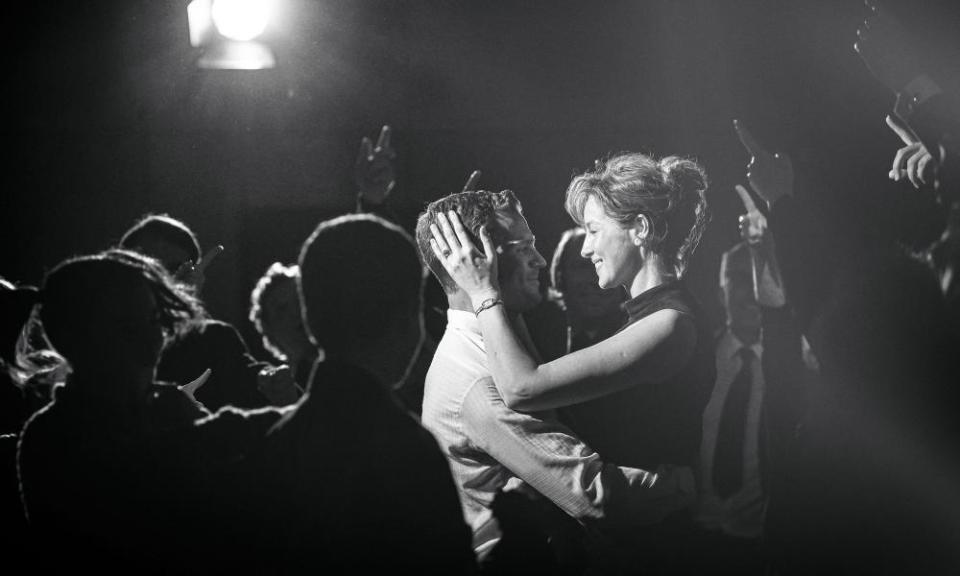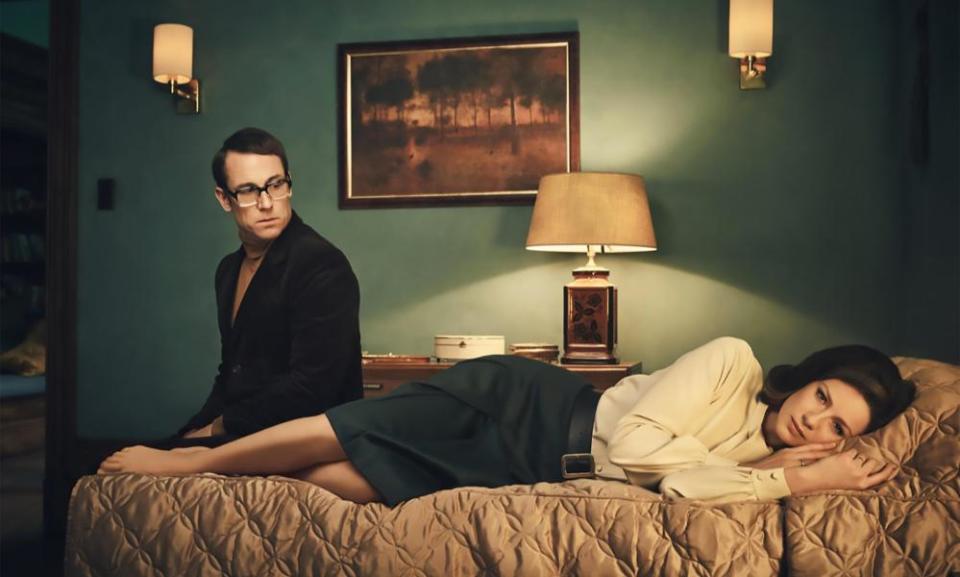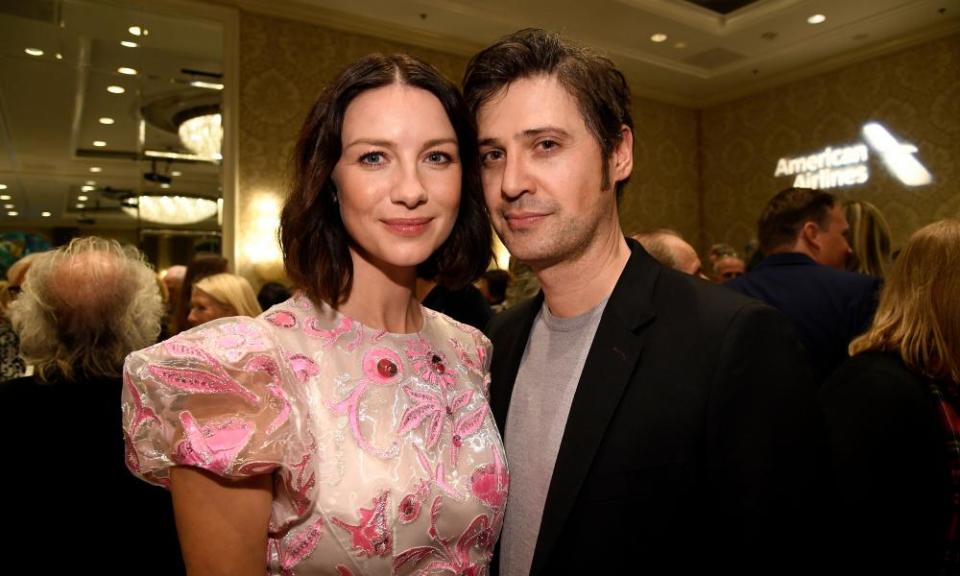‘I got really lucky’: Caitríona Balfe, star of Belfast, on fame, family and fans
Caitríona Balfe can remember the exact moment she realised she was done with being a model. It was the mid-2000s and Balfe was 27-ish, she thinks. It had been almost a decade since she’d been scouted in a Dublin supermarket while rattling a tin for a multiple sclerosis charity. She had done pretty well, walking in runway shows for Louis Vuitton and Chanel, flitting between Paris, Milan and New York. Balfe and her friends called themselves “the blue-collar models” – they weren’t the 0.1% of supermodels, the household names, but the next rung down.
Now, though, Balfe was in Dallas, doing a well-paid but soulless shoot for a catalogue. After each set-up, a producer would ping a little bell to indicate they needed to fast-change to the next outfit. At her age, in that youth-fixated business, Balfe knew the clock was ticking. She’d handled just about as much blunt rejection as she could take for one lifetime. “The shows were fun and exciting, but with catalogues, you’re just standing there like a clothes horse – literally,” says Balfe. “And you know, ‘This is not what I want to be doing with my life.’
“Modelling does two things,” Balfe continues, with a wry laugh. “It gives you a really, really tough exterior and then a really broken interior. Everyone’s experience is different, but I know my confidence and my self-esteem when I finished was in the toilet. Being in that for so long can leave you pretty messed up for a little bit.”

It’s only a mini-spoiler to mention at this point that things eventually worked out rather well for Balfe, who is now 42. That’s why we’re sitting this morning in early December in a very flash London hotel, sharing a bottle of mineral water that costs only fractionally less than a decent bottle of wine. She is wearing an oversized Lauren Manoogian midi-dress and is the first person I’ve seen make a face mask look glamorous. We now know that, after stopping being a model, Balfe would go on to star in five seasons and counting of Outlander, the wildly popular TV franchise. Later this afternoon she will find out that she has been nominated for a Golden Globe for her luminous performance in Belfast, Kenneth Branagh’s new film. An Oscar nod is presumed (by critics and pretty much everyone else, except Balfe) to follow next month.
But back in Dallas, on the catalogue shoot, the transition didn’t seem so obvious. Before Balfe’s “detour” into fashion, she had studied acting at the Dublin Institute of Technology and after quitting modelling she took it up again, attending drop-in classes in New York. “Somebody should just put a camera in one of those rooms,” she says. “Absolute insanity!” She landed a blink-and-you’ll-miss-it gig as an extra on the 2006 Meryl Streep film The Devil Wears Prada, in which she thinks her legs might be visible in the opening scene as a collection of well-heeled feet are walking into the offices of Runway magazine. Balfe couldn’t be too picky back then, but she learned that it was these kinds of roles that she shouldn’t be pursuing.
“So many actors used to work in bars or used to be this or that, but you come with a lot of stigma when you’ve been a model,” she says. “And that’s a hard thing to overcome, that being the first thing that people thought of me.”
There were plenty of rejections in acting, too – perhaps even more than in fashion – but Balfe found these somehow more palatable: at least she usually got to open her mouth before being passed over. “In an audition, if it didn’t work out, it wasn’t always because you didn’t do a good job, or you weren’t good,” she reasons. “It was other arbitrary things like your name’s not big enough. Which can also be soul-destroying, but I don’t know, it’s different.”
After a few years, Balfe went up for the pilot of a new series about a Second World War military nurse, Claire Randall, who finds herself transported back in time to the Scottish Highlands in 1743. “It was a total crapshoot,” says Balfe. “I had done a few jobs, nothing of note really. I was living in LA and I was really struggling, actually, it was about four or five months since I’d had a job.” She taped an audition, heard nothing. She got a new agent, sent in another tape, still nothing. She booked a holiday with friends to India. It was while her passport was at the Indian embassy that Balfe heard she needed to get to London, like now, for a final screen test.
Outlander has built up a devoted fanbase over five seasons on Amazon Prime in the UK and Starz in the US. But back in 2013, Balfe had no idea if the show would survive beyond its pilot. “So I signed on for six seasons at that point,” she says. “I mean, you’re broke, you’ve got nothing else going on. My lawyer was like, ‘You do realise this is shooting in Scotland? You’ll be there for a year for the first season?’ I was like, ‘A year’s great, a change of scenery, I’m not doing much in LA anyway.’ Yeah, I didn’t realise I’d still be there almost eight and a half years later.”

All of which is to note that, as the awards nominations roll in for Belfast, maybe even pitting her against Streep in the best supporting actress category, Balfe is no overnight success. “I feel like I’m at that place in life where, what’s happening now, I know it doesn’t happen all the time,” says Balfe. “It’s lovely, but it doesn’t mean you’re super-important.”
Balfe was born in 1979 and grew up in Tydavnet, a village in rural Ireland, not far from the border with Northern Ireland. Her father was a police sergeant, a tough, often unpopular job in the peak of the Troubles, and her mother mainly looked after their five children (Balfe was the fourth) and two foster children. She has been reflecting on this period a lot since reading the script for Belfast, which Branagh wrote about his own childhood in the city in the 1960s.
For Balfe, there was the time when she was in the car with her cousin and they were stopped at a checkpoint by a British soldier with a gun. This was a regular occurrence for Balfe, but her cousin, from Kildare, had no idea what was happening. “She started freaking out and was crying and screaming, ‘Don’t shoot my mum! Don’t shoot my mum!’” says Balfe. “It was just not her experience.” Another time, when she was 11 or 12, Balfe snuck up to the top floor of a café in nearby Monaghan with a friend to smoke cigarettes, and when she came down there had been a bomb scare and the town had been cleared.
“My sister was supposed to be looking after me and had obviously been looking for me for ages,” says Balfe. “So she was scared and when she found me, she slapped me. When I tell this story, my sister is always like, ‘I can’t believe you’re accusing me of child abuse!’”
Branagh’s film centres on Buddy, an ebullient nine-year-old from a Protestant family, played by Jude Hill. His Pa (Jamie Dornan) works as a joiner in England, as Branagh’s own father did, while his Ma (Balfe) does everything else back home. It’s set in 1969, just as barricades are appearing on streets in Belfast, separating Catholics and Protestants who had previously lived cordially enough as neighbours. Pa wants the family to relocate to England or Canada or Australia, where the work and the money are, but Ma is more resistant, wanting to stick with their friends and Buddy’s grandparents (Judi Dench and Ciarán Hinds).
This might sound like a bleak premise, but Belfast is one of the warmest, most charming films you will see this year. Soundtracked by Van Morrison, there is nostalgia here, but also a recognition that, however grim the Troubles became, there was also warmth, generosity and even remorse about what was happening.
“It’s strange, because obviously some of the material is so heavy, but because it’s done through the eyes of a child it never feels that way,” Balfe says. “It’s so joyous, you come out of that movie just feeling… full.”
Branagh was keen to enlist actors who would bring a personal resonance to the film: Dornan and Hinds are from Belfast; Dench’s mother was from Dublin. The first time they came together, Branagh encouraged them to share tales of their own parents and upbringings. “So I’m not thinking of Judi Dench as Dame Judi Dench, the titan of acting, but I’m thinking of the little girl and her stories,” says Balfe. “It just levels everybody. And I think we all understand something of each other – all of us have left our home and not returned.”
Balfe’s Ma is loving but fierce, with a wit and pragmatism that ensures the film doesn’t drift into schmaltz. “To Ma she brings a generosity of spirit that makes the character engage the audience without being ingratiating,” says Branagh. “The other quality she had that was certainly present in my mother – probably everyone’s mother? – was a ferocity of passion when protecting her young. You would not want to be in Caitríona’s way: she’s a very thoughtful, very considered person, but there’s a lioness an inch from the surface. I’d want her on my side in a fight. No question.”
Belfast lands at a busy time, perhaps even a chaotic one, professionally and personally, for Balfe. Last August she and her husband, music producer Tony McGill, had their first child, a son. Balfe is well aware of the awards chatter for the film, but life at home, changing nappies, grabbing sleep when she can, provides some perspective in case she becomes too carried away thinking about little gold statues.
“Luckily, I’m doing a lot of that [changing nappies], so I’m actually not thinking about the awards too much: it’s more ‘Stop peeing on me!’” she exclaims. “No, if it ever happened, I’d be bloody excited, but I don’t think you can chase that stuff, because that really does make you crazy.”

Balfe and McGill live a “nomadic” existence, spending time in London and Los Angeles, but living most of the year in Glasgow while she shoots Outlander. The sixth series of that show will return on 6 March, ending a hiatus that diehard fans have called the “Droughtlander”. It was a testing season to film, back in the winter of 2021. There were Covid protocols and the bitter Scottish climate to contend with. The material was challenging as well: at the end of the fifth series, Balfe’s character Claire was brutally raped, and there was a deep, psychological and physical reckoning that came with that. All while Balfe herself was pregnant.
“Claire’s story was very heavy this season,” says Balfe. “And it’s very heavy material as well. So I was just like, ‘Does your body know if you’re pretending to be stressed and upset and angry?’ Because you’re going through all the motions to get yourself into a state where you’re crying or shouting or scared, and there were times where I must have been four or five months pregnant and I’m running around shooting guns. And I’m like, ‘What does this child think?’ It must be like, ‘Who the fuck is my mother? What am I being born into?’”
Belfast may be some people’s introduction to Balfe, but she already has a loyal following thanks to Outlander. Some have been there since the start, others found the very bingeable show during lockdown. One sign of its popularity comes each year on Balfe’s birthday: 4 October. In 2020, when she turned 41, a group of fans decided to plant 41 trees in her honour. (Why trees? Balfe’s not totally sure, but she does follow the charity One Tree Planted, which plants a native tree for each $1 pledged, on Instagram.) This quickly became 410 trees, and when Balfe and her Outlander co-star Sam Heughan lent their support, it all became a little crazy. That year more than 55,000 native trees were planted, everywhere from Uganda to the Andes. A similar number followed in 2021, creating a “Balforest” of more than 100,000 trees.
“That’s not nothing,” says Balfe. “Sometimes people look down on shows like this and fandoms like this, but they’re amazing. And it’s funny, I do say sometimes it feels like I have thousands of stage mums. In the most beautiful way. Anything I do, they’re right on it and like, ‘Go on!’”
As for what is next, Balfe has recently started shooting the seventh series of Outlander. Diana Gabaldon, the former Disney scriptwriter whose novels inspired the show, has suggested there will be 10 books in the series, but at the moment Balfe and Heughan have only committed to seven. Balfe would like to direct, and has optioned Sara Crossan’s novel Here is the Beehive to potentially produce and star in. But before that, she has a baby to look after and an awards season to contend with. Balfe is unlikely to be short of offers after that.
“For someone who started in the industry so late, it’s been incredible,” says Balfe, looking a little perplexed at the run she’s having. “I don’t know, I got really fucking lucky.”
Belfast is in cinemas now; Outlander resumes in March
See full photoshoot here. Fashion editor Jo Jones; makeup by Mary Wiles at One Represents Using Kat Burki Skincare; hair by Gareth Bromell at Premier Hair and Makeup using Sisley Haircare; nails by Robbie Tomkins at Premier Hair and Makeup using Dior Manicure Collection and Miss Dior Hand Cream; digital technician Andy Mayfield; photographer’s assistant Alfie Bungay; fashion Assistant Peter Bevan; shot a Big Sky studios

 Yahoo Movies
Yahoo Movies 
